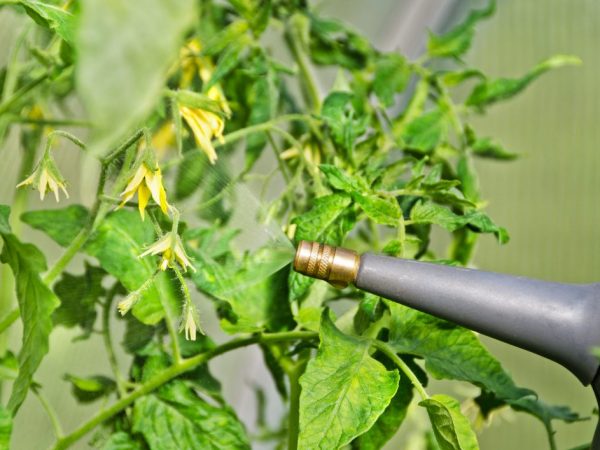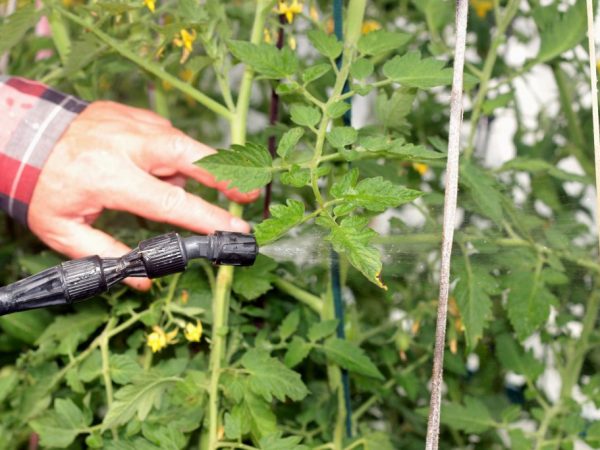How and how to spray tomatoes after rain
Often, gardeners are wondering how to spray tomatoes after rain. Is it necessary to process tomato bushes after precipitation and what is better to use? Let's consider how to carry out such a procedure.

Spraying tomatoes after rain
Rainwater damage
In rainy and damp weather, a fungus develops on tomato bushes. The presence of drip-liquid moisture on the leaves promotes the spread of late blight spores, which affects tomato bushes. Frequent changes in temperature and increased humidity only provoke the spread of infection.
Tatiana Orlova (Candidate of Agricultural Sciences):
Tomato has a high demand for soil moisture. With a lack of water, it stops growing, discards buds and ovaries. On the other hand, the tomato suffers greatly from high air humidity (optimal 45-50%). At high air humidity, the flowers are poorly pollinated and also crumble.
Young seedlings are most vulnerable during the dive period. Plants in the greenhouse are also infected. It is important to process the tomatoes in time to prevent infection with the fungus and prevent its reproduction.
How to spray the bushes
Dairy products
Gardeners recommend using available tools in the fight against fungal diseases, namely dairy products:
- Serum. The components of the whey composition feed and strengthen the tomato stems. Lactic acid stops the spread of fungal spores. For 1 liter of cold water, take 1 liter of serum and spray the bushes every day for 2 weeks.
- Kefir. A solution (10 l of water, 1 l of yogurt) is sprayed every 7 days before harvesting.
- Milk with iodine. To fight the fungus, take 10 drops of iodine in half a liter of milk, the resulting mixture is sprayed with tomatoes for 3 days. For prevention, it is recommended to process the mixture every 15 days (1 liter of milk and 15 drops of iodine per 8-9 liters of water).
Potassium permanganate
A mixture of potassium permanganate and garlic has an excellent preventive effect. For 2 cups of warm or hot water, you need to take 200 g of chopped garlic, mix thoroughly and leave for 24 hours in a dark place. The prepared mixture is filtered.
The indicated proportion is for 2 buckets of water. Tomato bushes are sprayed on dry seedlings after rain. After 14 days, the procedure is repeated.
Ash solution
Spraying the bushes with an ash solution helps kill the fungus and prevents infection. To prepare an antifungal mixture, 20 g of ash is dissolved in 1 liter of warm water. After 48 hours, the bushes and the soil under them are cultivated.
The components of the wood ash composition serve to strengthen the immunity of tomatoes and stimulate their growth. Tomatoes and soil around are powdered with ash well sifted through a sieve.
Bordeaux mixture

It is important to be careful when spraying
Bordeaux mixture is a well-known remedy for the prevention and treatment of fungal diseases. The preparation contains lime, copper sulfate and water.It is quite toxic, and if the proportions are not observed, the entire garden bed can be destroyed.
Tatiana Orlova (Candidate of Agricultural Sciences):
A sign of exceeding the concentration of the Bordeaux liquid solution above the permissible value during processing is the appearance of a brown mesh and a border on the leaves. At the same time, the leaves become tough and curl inward.
For tomatoes, it is recommended to use a minimum concentration of 1%, no more. To prepare the mixture, take 50 g of copper sulfate, the same amount of slaked lime per 5 liters of warm water. It is forbidden to cook the mixture in metal dishes. When spraying, it is recommended to use protective gloves and a respirator.
Yeast
Using yeast is a very simple and effective method to use: melt 50 g of yeast in 5 liters of water (warm). The resulting mixture is used to process the bushes when the first signs of the disease appear.
Yeast is also used as a nutritional supplement. For each liter of water, take 10 g of yeast, 50 g of chicken droppings, 50 g of ash and 1 tsp. Sahara. Tomatoes are treated with a solution once a week.
Boric acid
Boric acid is a drug with an antiseptic effect. They are treated with tomatoes, finely sprayed on the bushes during flowering and fruiting. The acid is dissolved in hot water: 1 g of the drug for each liter.
Boric acid is used not only for the prevention of fungal diseases, but also as a quality fertilizer. In the same proportions, fertilize the soil under the bush every 2 weeks.
Antibacterial drugs
You can also spray tomatoes after prolonged rains with antibacterial drugs that are of little danger to humans and animals:
- "Gamair" is a biological bactericide, a therapeutic and prophylactic agent against fungal diseases both on plants and in the soil.
- "Glyokladin" is an environmentally friendly preparation for disinfection and restoration of soil microflora.
- "Fitosporin" is a microbiological preparation for the treatment of both plants and soil for the prevention of fungal diseases.
- "Alirin-B" is a biological agent based on natural bacteria that inhibits the development of fungal spores and has a good healing effect.
Fungicides

Can be applied to wet bushes
Fungicides are very effective - preparations of chemical (Thanos, Ridomil Gold, Quadris, Strobi) or biological (Fitosporin, Acrobat, Ecosil, Difenoconazole) origin, which help to delay development infections.
One of the most effective in the fight against fungus is the Strobi fungicide. A single use of the drug per season is enough. It is important to use it before fruit appears as it is toxic. The advantage is the ability to use it in wet and rainy weather on wet bushes.
Fungicide "Quadris" helps to stop the spread of infection, but does not completely kill it. Means "Ridomil Gold" protects tomatoes both inside and outside.
Trichopolus
One of the most effective remedies remains trichopolum - a non-toxic bactericide with an antifungal effect. The proportion of the solution: 1 tablet of the drug is dissolved in 1 liter of water.
It is recommended to add liquid soap or a little milk to the resulting solution (25 g of additive for each liter of water). You need to be extremely careful in the use of the drug, since it is one of the antiprotozoal medicines.
Fungal infections are able to adapt to the composition of chemical preparations, therefore it is not recommended to treat them for a long time with one remedy.
Late blight treatment
Late blight (late blight) is a dangerous disease (fungus) that appears after prolonged rains. It is first the leaves, and then the whole plant, including the fruits. The first signs of late blight on tomatoes are the appearance and rapid spread of rusty spots on the leaves. In rainy and damp weather, a white, fluff-like coating becomes visible on the infested leaves underneath.
Fruits become gray-stained and deformed, and in later stages begin to rot. In no case should you eat contaminated fruits. The leaves turn black and curl. The fungal disease affects the bushes and spreads very quickly. After infection, the plant dies in 1.5-2 weeks.
After the first signs of infection appear, immediately after the rain, the infected leaves and fruits are immediately removed from the tomato bushes, which are subsequently burned. It is also recommended to harvest the fruits unripe. Tomatoes must be thoroughly washed before eating and disinfected in hot water. In this way, you can partially save the crop.
Tatiana Orlova (Candidate of Agricultural Sciences):
To disinfect green tomato fruits taken from plants with late blight, they are immersed in hot water at a temperature of 60-65 degrees for a few seconds. After that, immediately dry the fruits by wiping them with a paper towel.
You can save the crop by spraying the bushes with table salt (100 g of powder for each liter of water). The solution is very strong, it is recommended to use it in cases where the plant is affected by more than 50%. The tool will burn not only infected leaves, but also healthy ones, and stop infection of the fruit.
Prevention of the development of fungi
There are basic rules for the prevention of diseases:
- avoid the neighborhood with potatoes (danger of infection with late blight);
- change the landing site every 2-3 seasons;
- remove the lower leaves that touch the ground;
- plant bushes at a distance of 20-30 cm for early varieties and 30-40 cm for later ones;
- choose soil with a high nitrogen content;
- avoid getting liquid on the leaves when watering the bushes;
- choose early varieties (the fruiting period of which occurs before the appearance of phytophthora);
- treat seeds with fungicides.
Tatiana Orlova (Candidate of Agricultural Sciences):
Tomatoes should not be watered by sprinkling - spray them with a hose. The best irrigation methods are overflowing into beds with a calm water flow and drip irrigation. The so-called "dirty watering", when water with eroded soil particles gets on the leaves - a direct path to the appearance of fungal infections.
Conclusion
Timely preventive actions help to protect tomatoes from infection after rain and preserve the harvest. Timely sprayed bushes are more resistant to fungal attack. You also need to seriously consider the choice of varieties and soil for planting.
If the disease still partially damaged the plant, they use means that can save the crop, if not completely, then at least partially.



